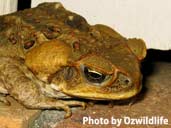 |
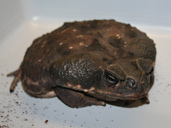 |
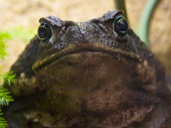 |
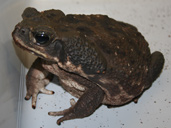 |
Cane Toad Care Sheet
Common name: Cane Toad, Marine Toad or Giant Toad
Scientific name: Bufo marinus
Description
Description: Cane Toads are large, heavy bodied toads with warty skin and noticeable Parotoid glands behind the ridges above their eyes. They tend to be olive brown to grey in colour, with paler underbellies that are sometimes flecked with black.
Size: Males can grow up to about 10-15cm (4-6 inches), whilst females are larger and can reach about 13- 23cm (5-9 inches).
Life span: Cane Toads can live up to 15-20 years generally, but lifespans of up to 40 years are not unheard of.
Origin:Cane Toads are native to Tropical Central and South America and occasionally have been found as far north as Southern Texas in North America. Cane Toads have been introduced into other parts of the world including Australia, Hawaii, Eastern USA , and the Philippines to control various pests. They have also spread throughout the Pacific and now inhabit the West Indies and New Guinea.
Habitat: Cane Toads are a terrestrial species that can be found in open grassland and woodland. They thrive in a sub-tropical environment. They also do well in Suburban areas and it is not uncommon in Florida and Australia to find these toads scavenging through vegetable matter in rubbish/garbage or crowding around dog food bowls that have been left outside. They also adapted to use street lighting to their advantage by crowding around the lights and waiting for any insects that are attracted to become their next meal.
Despite being sometimes referred to as the Marine Toad, these toads do not live in marine areas (although they are hardy enough to handle slight salinity in their water). The Marine part of the name is actually derived from the Latin name, Bufo marinus, and not because Cane Toads have any affinity with the sea.
Interesting facts about the Cane Toad.
The Bufotenin, which is one of the chemicals excreted by the Cane Toads Parotoid glands, is a Class 1 drug in Australia, due to its ability to cause mild hallucinations. This places it alongside both heroin and Marijuana.
Cane Toads are considered a great pest in Australia, as they have such a negative effect on native wildlife. Australians have come up with some ideas on what to do with the Cane Toads after being culled. The skin of the Cane toad has been successfully made into leather to make purses and keyrings and they have also devised a way of making a liquid fertilizer out of the remains too.
Things to consider before purchasing your first Amphibian
• Who will look after your new pet if you are away?
• Can you obtain its food easily from your local pet shop?
• Would you be comfortable feeding live insects as food?
• Are you comfortable having live food in the house to feed your pet?
• Is the rest of the family happy to live with an amphibian?
Captive Care
Temperament
Cane Toads are great first amphibians for beginners, because they are docile and relatively easy to care for. They are also a very hardy species, so it is unlikely that your pet will become ill.
Cane Toads can be tamed easily and can even begin to recognize their keeper. They are one of the few amphibians that can be handled, but extreme care needs to be taken when doing so (see Handling section below).
Cane Toads are a nocturnal species, so are relatively inactive during the day.
Feeding
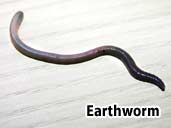 |
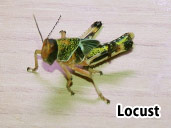 |
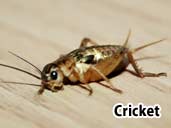 |
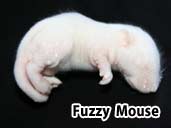 |
Cane Toads can usually handle any prey items that are suitably sized and can fit their mouths, which is probably the reason behind their success in the wild. Their ability to adapt their diet to even include carrion (dead prey items), production animal feeds and waste vegetable matter has meant that they have colonised many parts of the world and become pests in some places.
Pet Cane toads should be fed a variety of items, such as earthworms, locusts, crickets, cockroaches, mealworms, moths, beetles, butterflies and waxworms. Rodents, Cat/Dog food and lean meat can also be given to your adult Cane Toads, but these should be regarded as treat items as regular feeding of these things as a staple food item can lead to obesity.
Adults should be given calcium and D3 supplements at least once a week, whilst juveniles will require their food to be dusted more regularly. 2-4 times a week should be sufficient dependant on growth.
Using feeding tongs or forceps is advised when feeding your Cane Toad.
Housing
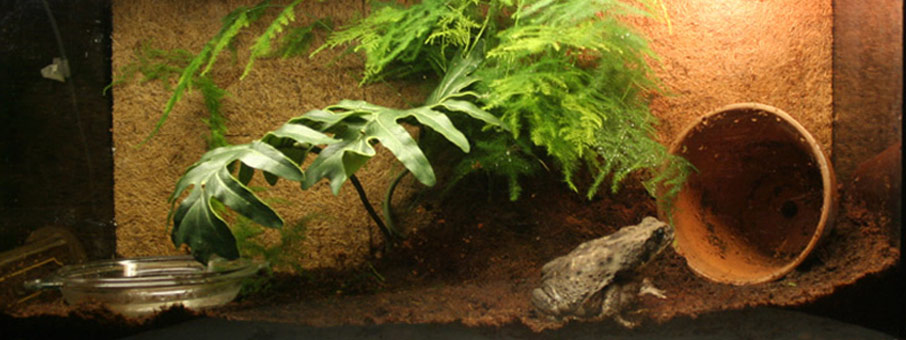
Cane Toads need really large enclosures as they will grow to quite a size and are fairly active.
A glass tank, plastic RUB (really useful box) or a terrarium make good homes for Cane Toads. They prefer a woodland/savannah/sub-tropical rainforest type set up.
Your terrarium should contain:
Substrate
Coco husk, Eco-earth and fertilizer-free soil are good substrates to use, along with live moss and sand. A simpler, but less attractive substrate is paper towels. These are cheap, fit for purpose and easy to clean if they become soiled.
Water
All amphibians need fresh water daily. A large, shallow water bowl should be provided containing de-chlorinated or bottled spring water. Tap water may be used as long as it has either been treated with a de-chlorinating solution or been left to stand uncovered for over 24 hours, so that the chlorine can evaporate. The depth of the water should be no higher than the height of your Cane Toads mouth when at rest.
If you would like a more elaborate set up then a 50/50 split to the tank is also an option. Dedicate half the terrarium to terrestrial burrowing space and the other half to a water area. A filter may be added to help keep the water clean and it is advisable to have a ramp between the two areas to aid your toad when leaving the water.
Cane Toads, like most amphibians, will soak up water through their skin and since their water bowl is used as the main place to defecate it is important that it is cleaned daily.
Humidity
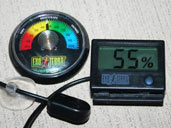 Cane Toads require high humidity within their terrarium. Lightly misting the terrarium a few times daily with de-chlorinated water in a spray bottle should suffice to keep humidity at the right level for your Cane Toad.
Cane Toads require high humidity within their terrarium. Lightly misting the terrarium a few times daily with de-chlorinated water in a spray bottle should suffice to keep humidity at the right level for your Cane Toad.
Ensure that between mistings the substrate remains damp, but not water logged.
An Hygrometer (humidity gauge) is a useful addition to your Cane toad's enclosure to monitor the humidty and ensure it is at a suitable level. Both digital and dial hygrometers are readily available from reptile stockists and a reasonably cheap.
A place for your Cane Toad to hide
All amphibians require somewhere to hide and may become stressed if this is not provided. Inexpensive plant pots, aquarium ornaments, logs, branches, stones, live and plastic plants can be added to give your Cane Toad the opportunity to hide.
Heat
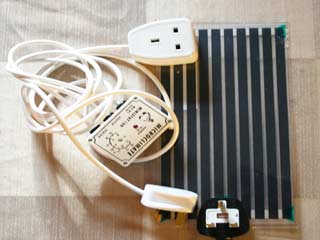 The ideal temperature for your Cane Toad is around 23-28°C (73- 82°F), with a slight drop to around 20°C (68°F) at night time.
The ideal temperature for your Cane Toad is around 23-28°C (73- 82°F), with a slight drop to around 20°C (68°F) at night time.
During the summer months, room temperature may be suitable, but in the winter additional heat maybe required. Heat should be provided using a heat mat on the side of the tank with an appropriate thermostat.
Heat mats should only cover a third of the wall space to allow your Cane Toad to thermo-regulate. The mat should be along the wall space because Cane Toads are large bodied toads, so the risk of burning your toad with a under tank heat mat are higher than with smaller types of amphibian.
Never use heat lamps or basking lamps for amphibians, as these can cause your Cane Toad to dehydrate.
Lighting
Cane Toads should be kept out of direct sunlight to ensure that the light from the sun does not generate too much heat within the terrarium.
Cane Toads do not need the addition of UV lighting if they have enough vitamins and variation in their diet. Although you may find the live plants in your terrarium will die without any light. A fluorescent low UVB tube is ideal as it won’t give out any heat and will help the plants thrive. You should place the light at one side of the terrarium creating a light gradient so your toads can find a darker place out of the light if preferred. Ideally you should cycle the lighting to mimic the toads natural habitat by having a 12/12 system - 12 hours of light and 12 of dark.
Cleaning
Daily spot cleaning is required and any defecation should be removed if possible to do so. You will also need the clean the water bowl daily.
Your entire terrarium should be completely cleaned out on a 2-4 week basis. Your Cane Toad should be moved to a temporary tank whilst being cleaned. All substrate and décor should be removed and refreshed.
Use an amphibian safe disinfectant to clean the terrarium to prevent the build up of bacteria, but always ensure that all chemicals are thoroughly rinsed away, so that there is no chance that they will harm your Cane Toad.
Handling
Cane Toads are one of the few amphibians that can be handled, but it should not be done too regularly or for prolonged amounts of time. It is advisable to wash your hands both before and after handling. This is because the white Bufotoxin that oozes out of Cane Toads Parotoid glands is highly toxic and can cause skin irritations or burn your eyes and mucus membranes. Although there have been no known deaths in humans due to handling a Cane Toad, the toxin is potent enough to kill dogs, cats and foxes, so it is definitely not a toxin you should under-estimate.
Cane Toads, like all amphibians, have delicate, absorbent skin and the oils and salts on our hands can cause them harm. Handling your toad with clean, wet hands makes it more unlikely that any substances on our skin will hurt your toad. Alternatively, Latex or surgical gloves can be worn during handling.
Sloughing
Cane Toads shed their skin at regular intervals as they grow. The old skin is pushed off with the hind legs and the skin peels off from the back end. The skin should come off in one piece and is normally eaten by the toad. The skin is pushed forwards using its legs towards the mouth.
Estivation
Estivation is the term given to the period of Hibernation that wild Cane Toads usually go into during the dryer months. They create a cocoon from old skin that helps to seal in moisture whilst the toad buries itself in the ground to wait for the rainy season to come.
Your Cane Toad is unlikely to go into estivation, if temperatures and humidity are controlled successfully, but if you experience a drop in temperatures or humidity within your terrarium, your Cane Toad may start to estivate.
You should not feed or disturb your Cane Toad during estavation, but fresh de-chlorinated water should always be available.
Bring your Cane Toad out of estivation by slowly raising the temperatures or creating higher humidity over a few days. This should awaken your Cane Toad and bring them back to normal activity.
Sexing
The easiest way to determine the sex of your Cane Toad is by listening, as males will call during the mating season. They also usually have darker skin on their throats and develop nuptial pads.
Females are larger than males and usually have a more rounded body shape.
Breeding
Cane Toads are a prolific breeder and can lay up to 30,000 eggs in one spawning. This is another of the reasons why they have become a pest in some parts of the world and are threatening the local wildlife there.
Cane Toads in captivity are unlikely to breed in a small terrarium, so if you are planning to breed your toads you will need a large pool or pond within a secure green house. Some Breeders have also found children’s paddling pools useful.
The breeding season for Cane Toads is early spring to autumn.
If you are successful, tadpoles will hatch within 3 days. They can be fed on usual micro foods suitable for tadpoles/larvae, but may also take finely chopped boiled spinach or frozen lettuce.
Other questions about the Cane Toad
If you have any other questions why not join The Amphibian Forum and ask one of the many experienced keepers. The reason this website was set up was so people in the amphibian keeping hobby could share their experiences with others.

